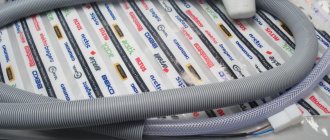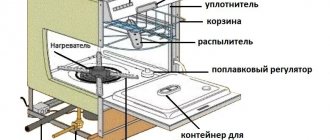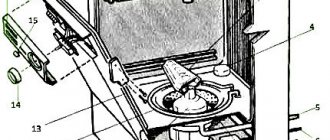Many buyers, when choosing equipment, do not pay attention to the power consumption of the dishwasher (hereinafter also referred to as PMM, dishwasher). They are more interested in the version of the PMM (built-in, free-standing or tabletop), the design and the number of dishes that the device can wash at one time.
The energy efficiency of large household appliances is improving year after year.
The electricity consumption of a dishwasher is one of the important characteristics that must be taken into account when purchasing a PMM, since utility tariffs are increasing from year to year.
Power and energy consumption: what's the difference?
Most people confuse these two indicators. In fact, there is a big difference between them. Energy consumption is the amount of energy that the dishwasher uses in one hour of operation . At the same time, individual parts of the PMM do not work continuously during this time.
For example, a tubular electric heater (hereinafter also referred to as a heating element) turns off after heating the water to the desired temperature. This will take him, for example, 10 to 15 minutes. The drain pump runs for a maximum of half an hour. At different stages of the operating cycle, different PMM nodes are involved, therefore the average energy consumption per hour of operation is determined. The calculation is carried out in kilowatt-hours (kW/h).
The energy consumption level is divided into classes - from A to G
Power is the amount of energy that the dishwasher takes from the electrical network in the event of simultaneous operation of all its components . How much electricity does a dishwasher use compared to its power? It turns out that the difference between the PMM power indicator and the energy consumption is very significant. Power is 2-3 times higher than the level of energy consumption, and its unit of measurement - kilowatt (kW) - is not tied to time . The cross-section of the electrical cable supplying electricity to the device depends precisely on the power that the dishwasher has.
What is energy consumption and energy efficiency class?
For you, as a buyer who wants to save on utilities, it is important to pay attention to the electricity consumption indicator or class.
This value is measured in W/h or kW/h. This is the amount you see in your monthly payment.
When you visit a store to buy a dishwasher, you will be able to see class labels on the windows. This indicator is assigned depending on the amount of electricity consumed by the PM. This classification allows you to quickly navigate the choice and select the most economical equipment in terms of electricity consumption.
In the table below you can see the classification by classes and their designations.
| Energy class | Electricity consumption in kW/h and characteristics |
| A+ or A++ | 0.4-0.6 kW/h. The most energy efficient PM. |
| A | 0.75-1.05 kW/h. One of the most economical PMs. |
| B | 1.056-1.38 kW/h. These are household appliances with an average level of energy efficiency. |
| C | 1.38-1.72 kW/h. Energy efficiency is slightly below average. |
Class A and B dishwashers are most often found on the market.
Electricity consumption classification
PMMs are classified not by power, but by energy consumption. All large household appliances have labels that indicate the level of energy efficiency of models of various brands - Bosch, Siemens, Electrolux and many others. The information on the tags of almost all products is systematized in the same way (see figure).
The sticker contains comprehensive information about the technical characteristics and operating efficiency of dishwashers
Interesting fact: such an indicator as power is not on the tags. There are energy efficiency classes. The most energy-efficient products are assigned classes A+++, A++, A+, and A.
Depending on the class, electricity consumption increases as follows:
- A+++ – 0.63 kW/h and less;
- A++ – from 0.65 to 0.75 kW/h;
- A+ – from 0.75 to 0.85 kW/h;
- A – from 0.85 to 1.05 kW/h;
- B – around 1.05–1.2 kW/h;
- C – in the range of 1.2–1.5 kW/h;
- D, E – from 1.5 to 2.3 kW/h.
Information about classes F and G is no longer relevant today. Most buyers choose products with classes from A to A+++.
Energy efficiency classes
On average, dishwasher energy consumption ranges from 0.7 to 1.1 kWh. To enable the user to determine how much electricity a particular model consumes, energy consumption (energy efficiency) classes have been introduced. This information must be applied to the body of dishwashers and other appliances. The energy efficiency class is assigned to an appliance based on the results of several test washes performed with the same number of dishes loaded.
The energy efficiency class has color and letter markings: A, B, C, D and so on. High levels of energy consumption are indicated by shades of green, while medium and low levels are indicated by yellow and red. Class A is further divided into subclasses (A+, A++, A+++). A+ dishwashers use about 0.8 kWh per cycle, and A++ models use about 0.7 kWh. All Miele dishwashers are awarded the highest energy efficiency class (A+++).
What components and parts affect energy consumption?
Each dishwasher consists of a certain set of components and parts. They all consume a certain amount of energy. The level of its consumption depends on the following components:
- The heating element is the most energy-consuming element. The power of this device that heats water for washing dishes varies widely and can exceed 2 kW. Its operating time depends on the water temperature level that is set in the selected program. The temperature range is quite wide - from +30...35 ℃ to +70...80 ℃. PMM models with forced drying have another heater that increases the air temperature, as well as a fan. Unlike devices with convection drying, such dishwashers have a higher energy consumption level.
- Circulation pump - pumps liquid into the nozzles of the spray arms, and also ensures the reuse of water in order to save it. The power of this pump is low, approximately 100 W. The longer the dishwashing program lasts, the more energy the appliance consumes.
- Drain pump - pushes waste fluid into the sewer. Pump power – from 30 to 40 W. The duration of its operation depends on the amount of dirty water that needs to be removed from the PMM.
Dishwasher drain and circulation pumps (bottom view)
Energy consumption indicators depend on several other factors:
- The amount of liquid consumed per washing cycle. The indicator ranges from 7-15 liters. The more water, the longer it needs to be heated. The operating time of the drain pump also depends on the volume of water.
- Duration of the washing process. The time depends on the program selected by the user and varies widely - from 40 minutes to 4 hours. This indicator affects the total energy consumption of the circulation pump.
- Basket sizes. This indicator determines the number of tableware that can be washed in one cycle, and affects all others. If we compare narrow and full-size PMMs, the latter will require more water to operate, as well as a more powerful electric heater and pump for sprinklers. The units of small tabletop dishwashers have the lowest energy consumption and power.
The countertop dishwasher is the least productive, but the most economical of all types of PMM
Energy efficiency classes
Dishwasher power consumption (kilowatts) is divided into 7 groups, which simplify the selection of the most suitable equipment. Latin letters are used for designation:
- A. This rating is the highest and means low energy consumption. The average figure is 0.7-1.05 kW. The advent of modern equipment has led to the use of classes A+ and A++, the power of which is 0.6 and 0.4 kW, respectively.
- B. Equipment with a similar rating has an indicator of 1.07-1.1 kW.
- C. In the manufacture of dishwashers, component elements can be used, the total power of which is 1.1-1.5 kW.
- D and E. This class is an average rating, since the power consumption is 1.5-2.3 kW.
- F and G. The lowest energy consumption rating defines a dishwasher with more than 2.7 kW of power. This category includes exclusively old models.
Useful tips for using dishwashers
If you properly allocate resources and operating time of the dishwasher, you can save energy. Follow the recommendations below:
- Wash dishes at night when electricity rates are lower. To do this, you need to have a two-tariff electric meter and a PMM, which has a delayed start function. In the evening, turn on the device, select a washing program, start it and wait until the water in the tank finishes filling. Then stop the program and enable delayed start. Firstly, in the time before restarting, the water will have time to warm up to room temperature and less energy will be needed to heat it up. Secondly, the work cycle will be performed at night, when the electricity tariff is lower.
- Don't keep dishes dirty for too long , as dried food waste makes them more difficult to clean. You will have to run a program with soaking, double rinsing and washing at a higher temperature. Naturally, such a choice will lead to more energy consumed.
- Choose your washing program wisely - do not wash slightly soiled dishes with hot water for too long. For effective cleaning, an accelerated mode at a liquid temperature of +30...40 ℃ may be sufficient.
- Try to load the dishwasher as much as possible . Running a partially loaded PMM is impractical due to inefficient use of electricity. But if your model has a half-load function, use it.
- Regularly descale the heating element of your dishwasher. If the heater is covered with a layer of scale, it heats the water much worse, while consuming the same power as before.
Today, stores offer a wide selection of dishwashers for any family. When choosing, be sure to pay attention to energy efficiency rating labels - this will save you from unnecessary costs when paying bills in the future. You will find tips on choosing dishwashing equipment in our other article.
What is the difference between power and energy consumption?
Many people confuse these indicators, but they are significantly different. You can notice this from the description of the characteristics of the PMM in the instructions. As a rule, the amount of energy consumption is less than power. What causes this? To understand the difference, you need to know how a dishwasher works. The fact is that during the dishwashing cycle, different components are involved at different stages.
Electricity is mainly consumed by:
- Electric water heater (hereinafter also referred to as heating element). In 10-15 minutes it heats the liquid to the temperature specified by the program. Heating can be carried out both up to +40℃ and up to +70℃. But the heating element does not work constantly; after heating the water to the required temperature, the thermistor (temperature sensor) sends a signal to the control unit and the part turns off. The power of the electric heater can reach 2.5-2.8 kW.
- Forced drying system for dishes . It also includes an electric heater, but it heats the air, which is forced by a fan into the working chamber. Convection drying takes longer, but it also consumes 35-40% less electricity than during forced drying. This process also takes only part of the total operating time of the PMM.
- The circulation pump (pump) supplies liquid under pressure to the spray arms throughout the entire time of washing and rinsing kitchen utensils. This part works the longest during the operating cycle. But the power of the pump is small - around 100 W.
- The drain pump removes dirty liquid from the PMM into the sewer. It does not work for long and has the smallest power, up to 30 W.
Energy consumption is the amount of electricity used, expressed in kilowatts (kW), per hour of operation of the device. This indicator is expressed in kW/h units. But during this hour, individual energy-consuming parts can work in a matter of minutes. This is why the amount of energy consumption is much less than the power level.
The level of energy consumption depends on how much water is used for a full wash cycle, as well as on the selected program. The more water in the tank, the more energy and time is spent heating it. Work programs also differ greatly in the duration of dishwashing.
Power is the maximum amount of energy consumed in the shortest period of time (1 second), provided that all parts and systems of the dishwasher are working. Expressed simply in kilowatts (kW).
The two above indicators are usually recorded both on the PMM body itself and in the instructions for the device. They reflect a complete picture of how much electricity the dishwasher consumes. The efficiency of different dishwasher models is classified according to the level of annual energy consumption, and not by power.











